
TIC 300 PRO Non-Contact High Voltage Detector
MSHA certified and intrinsically safe, trusted by utility crews for over 20 years.
The Amprobe TIC 300 PRO high voltage detector is a non-contact voltage detector for detecting alternating current (AC) on transmission lines, power distribution equipment, downed power lines, fuses, electrical outlets, and other power lines. It detects voltages in low, medium and high voltage applications (30-122kVAC) with bright visual and loud alerts. It is rugged and reliable for utility, industrial, heavy manufacturing and mine safety applications. The TIC tracers get thrown around in utility trucks, but the units are built to withstand the rough treatment.
The TIC 300 PRO has a low-voltage setting (30 to 1,500VAC)
for checking voltage presence in breaker panels, breakers, power outlets and wiring. It also has a high-voltage setting (1,500 to 122,000 V AC when used with the TIC 410A Hot Stick attachment) for checking transmission lines, downed power lines and substations. The presence of AC voltage is indicatedby an LED light and audible beeper. It is MSHA certified and intrinsically safe. The TIC 300 PRO has a self-test that verifies thetester works properly and is drop-proof up to 6 feet.
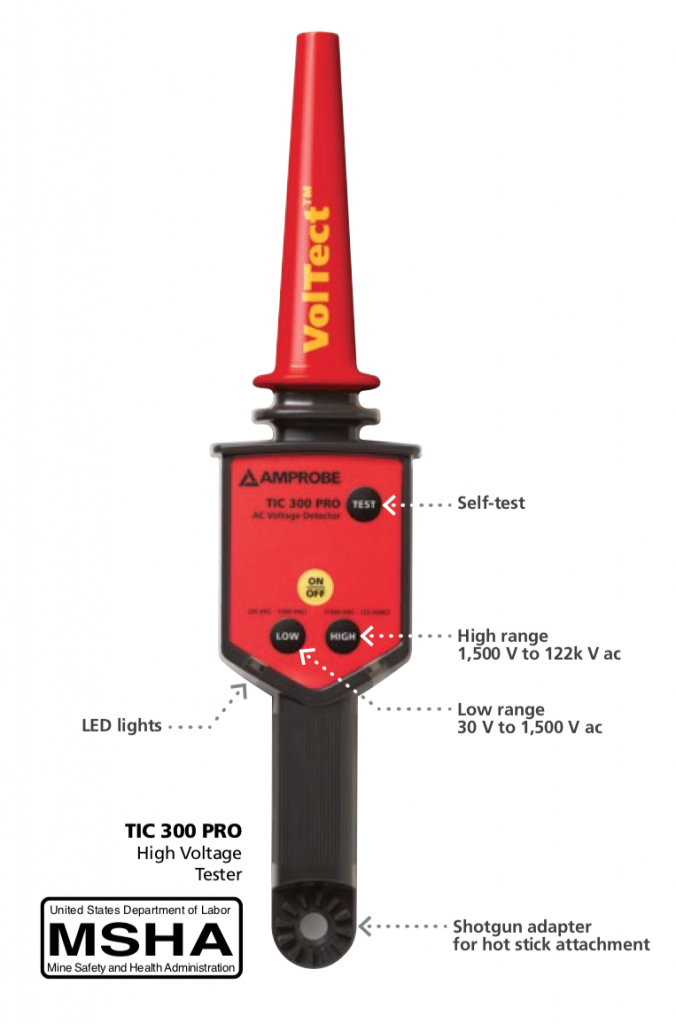
TIC 300 PRO Features
- MSHA certified and intrinsically safe
- Utility tool for checking transmission lines, power distribution equipment, down power lines, fuses, and load break connectors
- Visual and audible voltage indication
- High-voltage setting 1500 V ac to 122,000 V AC (with TIC 410A Hot Stick) for utility applications such as transmissions lines, power distribution equipment, down power lines, transformers and more.
- Low-voltage setting for checking voltage presence in breaker panels, breakers, power outlets and wiring
- A unique self-test feature so there is no need to connect directly to a current carrying conductor – saving your time and keeping you safe.
- Ergonomic design with a convenient handle
- Drop proof up to 6 feet
- PDF DATA SHEET
- PDF USERS MANUAL
- Utility tool for checking transmission lines, power distribution equipment, down power lines and load break connectors
- Lower voltage setting for checking voltage presence in breaker panels, breakers, fuses, power outlets and wiring
- Verifies presence of Voltage from 30 VAC to 122,000 VAC (122kV)
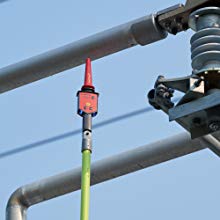
Is it Hot or Not?
The Amprobe TIC-300 PRO high voltage detector has been trusted by utility crews for over 20 years for verifying the presence or absence of voltage when it matters most – in high voltage environments. Lights flash and the TIC 300 Pro beeps with increasing frequency as it nears a source of electricity, leaving the user no doubt whether the area is live or not. Crews like how simple the TIC 300 PRO is to use. One bright yellow button turns it on or off, and two other buttons select high or low voltage ranges (a red light illuminates below which range has been selected). The buttons are also easy to push when wearing heavy PPE gloves. The unit tells you it’s on with an intermittent beep and a flashing light on the lower edge, easily visible from the user’s vantage point. A self-test feature verifies that the unit is working properly.
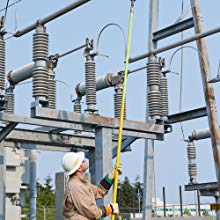
Rugged and Reliable
The Amprobe TIC-300 PRO high voltage detector is a non-contact voltage detector for detecting alternating current (AC) on transmission lines, power distribution equipment, downed power lines, fuses, electrical outlets, and other power lines. It detects voltages in low, medium and high voltage applications (30-122kVAC) with bright visual and loud alerts. It is rugged and reliable for utility, industrial, heavy manufacturing and mine safety applications. The TIC tracers get thrown around in utility trucks, but the units are built to withstand the rough treatment. Some units have been known to last more than 20 years.
Note: Image shows the TIC 300 PRO with optional TIC 410A.
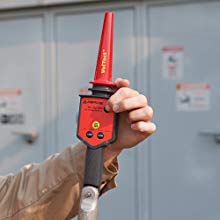
Packed with Features
The Amprobe TIC-300 PRO has a low-voltage setting (30 to 1,500 VAC) for checking voltage presence in breaker panels, breakers, power outlets and wiring. It also has a high-voltage setting (1,500 to 122,000 VAC when used with the TIC-410A Hot Stick attachment) for checking transmission lines, downed power lines and substations. The presence of AC voltage is indicated by an LED light and audible beeper. The TIC-300 PRO has a self-test that verifies the tester works properly and is drop-proof up to 6 feet.
Note: Image shows the TIC 300 PRO with optional TIC 410A.
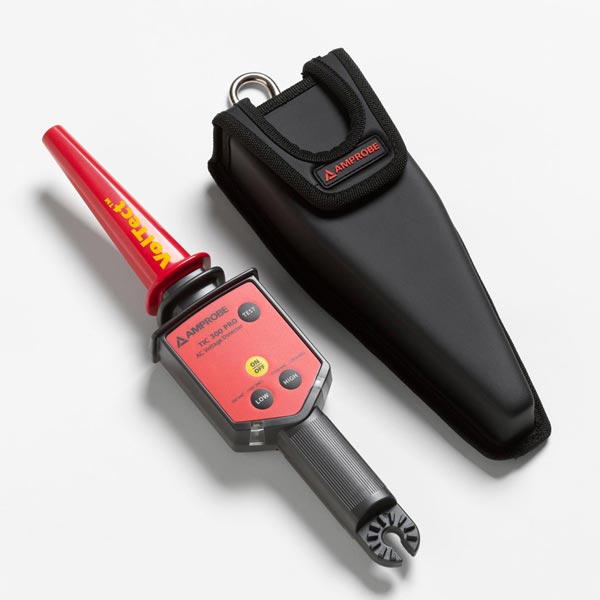
Included Accessories: Deluxe carrying case, users manual, 9 V battery (installed)

Amprobe TIC 410A Hot Stick Attachment
Physically and electrically extend your reach
The TIC 410A Hot Stick Attachment physically and electrically extends the reach of the TIC 300 Pro high voltage detector for checking transmission lines, power distribution equipment, down power lines, fuses, and load break connectors. The TIC 410A universal adapter extends the voltage limit on the TIC 300 Pro from 1500 AC to 122,000 VAC (122 kV) and adjusts from 33″ to 57″. Just screw it onto the universal adapter on the TIC 300 Pro high voltage probe – no other tools are required.

AEMC 275HVD Non-Contact AC High Voltage Detector, 240V to 275kV Range
- Non-contact voltage detector
- Wide range of detection; finds 80V to 275kV; one instrument fits all applications
- Powered by three standard Alkaline C cell batteries
- Self-test position ensures that all system functions and indicators are working properly by energizing the complete system
- Lightweight, minimizes sway at the end of long hot sticks
The Model 275HVD is designed to detect the presence of high voltage without physical contact. An eight position rotary switch selects the detection range. As the sensor is moved closer to the voltage carrying conductor, its sensor head picks up the radiated electric field. Once the threshold is reached, the buzzer sounds and a bright red warning light warns the operator of live conductors. The Model 275HVD is powered by three standard Alkaline C cell batteries and can be used both in- and out-of-doors. A universal spline on the back-end facilitates attachment to any standard hot stick. A self-test position ensures that all circuitry and annunciators are working properly before use.